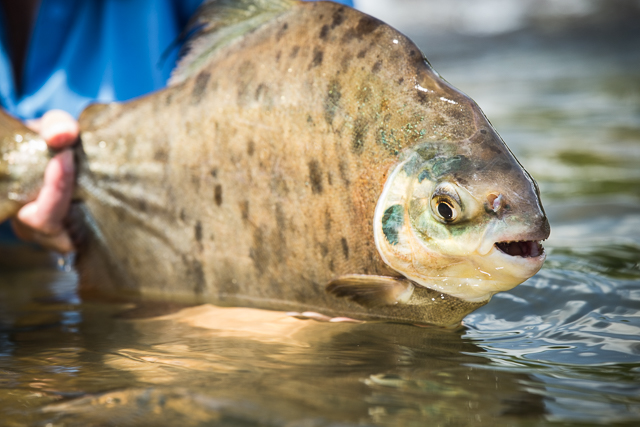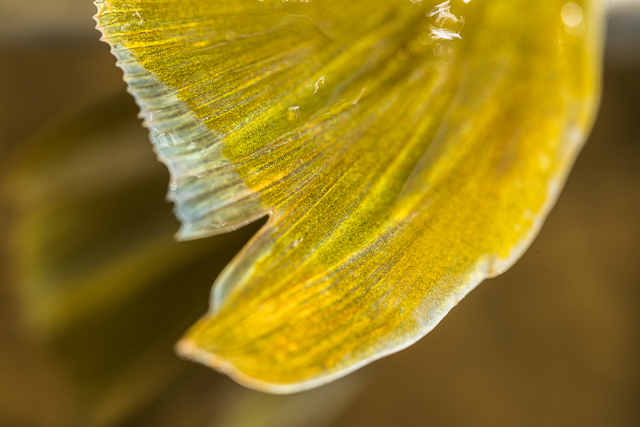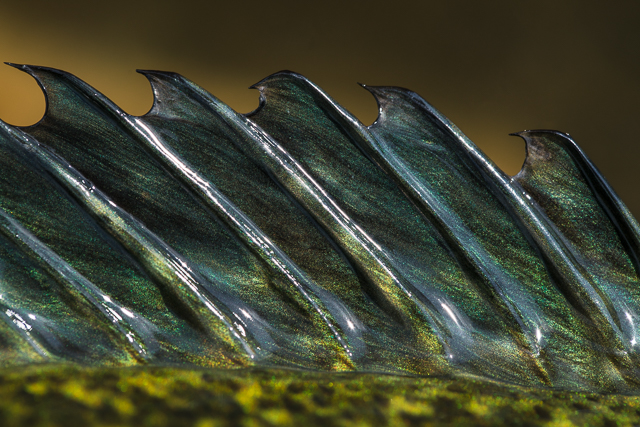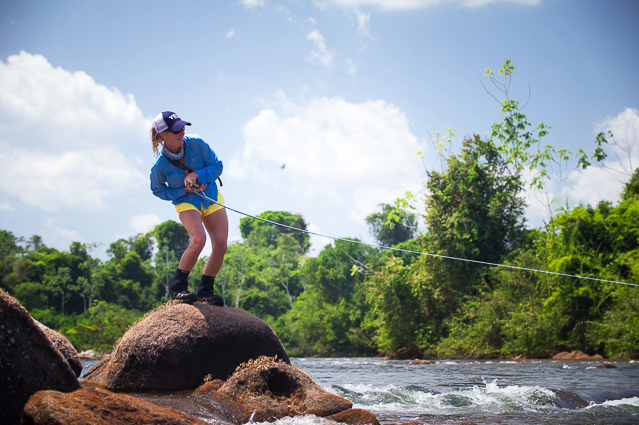
Meredith McCord and photographer Matt Jones of Tailwaters recently returned from jungle angling in Kendjam in the Amazon Basin of Brazil with Untamed Angling. We will be featuring Meredith’s daily record of her angling ventures in a nine-part travel journal. This is part three.
Day Three – Fly Fishing Kendjam and Our First Pacu
Last night I would wake up periodically to interesting new sounds. The generators turned off around 10:30 or 11 pm, but its batteries kept the floor fan and bedside lamp running for a few more hours. Once the fan went silent, other sounds were amplified: crickets, frogs, birds calling out to one another. But the most shocking sounds were from the howler monkeys “barking” and “screaming” at each other. Eerie but at the same time super cool.
Breakfast was served at 7 am with eggs made to order, bacon or ham, toast, pancakes and delicious hot coffee. Manuala, our Argentine hostess, served us up a delicious local juice from a fruit I have never heard of, and I had three glasses. Yum!
By 8 am we were rigged and ready to go. My weapons were as follows:
- Thomas and Thomas 5wt – Rio Grand Floating on Abel Super 5N (Dry Fly Rod)
- Thomas and Thomas 6wt – Rio Redfish Floating on Abel Super 5 (Dry Fly Rod)
- Thomas and Thomas 7wt – Rio Redfish Floating on Abel Super 7-8 (Popper/Streamer)
- Sage One 8wt – Rio Outbound Short Intermediate Tip on Abel Super 7-8 (Peacock/Trahire Streamer)
- Hardy 8wt Proaxis – Cortland 350gr sinking line on Ross Reel (Payara Streamer) (my Thomas and Thomas got busted on a trip earlier this year)
Payara time. Payara are one of the wildest looking fish of the Amazon with two bottom teeth that protrude like lower tusks on a wart hog. They’ve been allusive at Kendjam, and the code hasn’t been cracked on to how catch these large silver fish on the fly. While two have been caught in the shallows during Kendjam’s two-year existence, more have been hooked and caught in deep pools (ranging 6 to 10 meters deep). I like weird fish, and the record books for payara on fly for women is open, so off we go about 10 minutes from the lodge to a deep pool.
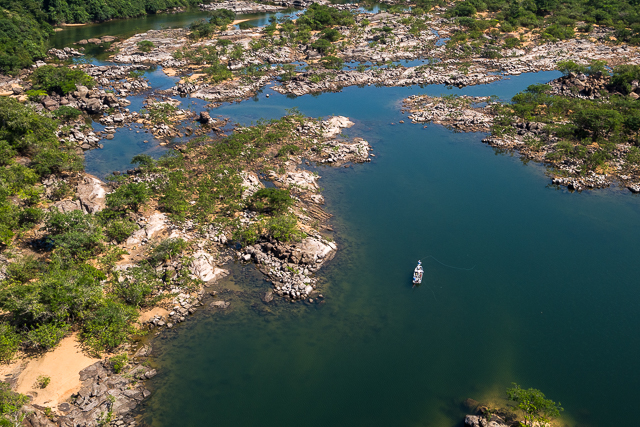
With a 5” long white baitfish fly rigged on my 8wt sinking line, I threw for an hour and a half with nothing, not even a bite. Not to mention that there wasn’t even a slight breeze, and the humidity levels were probably in the high 90s. Frustrated by watching the fish roll around me and having to wait 5-10 seconds every blind cast, I opted to find some fish I could actually see in this beautiful clear water. (One cool thing we did see while blind casting was a 3-4’ electric eel that came up to the boat to check us out and get a breath before slithering back down deep again. Apparently electric eels have incredible sense of hearing and can produce an electric shock strong enough to feel like a stun gun, causing a lot of pain and numbing to the body. Ugh.)
Gui, Roberto and I moved downstream with 7wt floating line, rigged with popper, and began to cast at the rocky shoreline. We saw a couple of rolls by some small pacu (about the size of my hand), but still nothing yet.
Trolling his fly in frustration as we moved, Roberto finally caught the first fish of the day – a small bicuda. These freshwater barracuda-looking fish are highly sensitive and must be handled quickly or it will die.
By 11 am, it’s obvious we needed to make an aggressive move, so we headed further downstream to find some fast moving waters and shallow rapids. For these waters, I used Thomas and Thomas 6wt Solar with a 9′ leader (30lbs twisted double strand butt to a single strand of 20lbs). Here the target was pacu and matrincha, which both eat dry flies. I showed Gui my box and, as usual, no matter where I go and how many flies I bring, my guide doesn’t look too thrilled. But one caught his eye: Umpqua’s Yellow Pool Toy Size 6.
Now we were in waters, and I could see lots of pacu. As I started with yellow dry hopper, I could tell that the pacu weren’t interested. So Gui suggested I go to a black dry fly; unfortunately, I didn’t have any black hoppers of the same size, so I, a lover of sharpies, used my black sharpie to “paint” it.
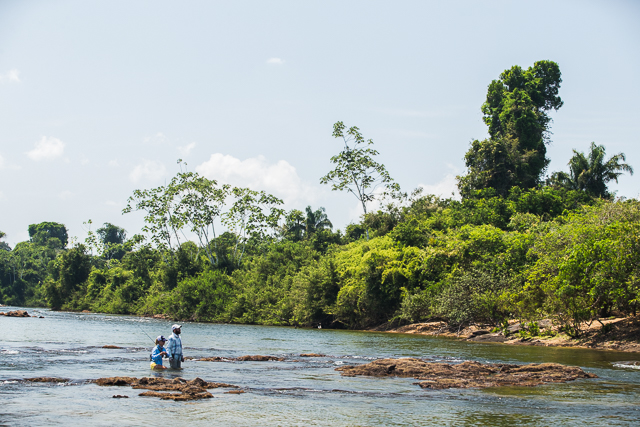
On my fourth cast upstream, I allowed it to dead drift back, and I got a full face “out of the water” ice cream cone eat. Pacu on. They’re dirty fighters, and this one went around me, wrapping me in a tangled mess. With no net, and standing in the fast rapids with my legs constrained by my fly line, the fight didn’t end well. The mischievous big pacu got off just as Gui leadered him. This wasn’t the best start to my day or my trip.
But always the optimist, I decided to look for new waters a bit further upstream. I casted in a rainbow formation, working the water up from me and letting my hopper float down towards me. Finally around noon, the strongest eat of the day happened: a matrincha. The bite was awesome and this fish fought like the bullet train, reminding me a bit of a bonefish. The matrincha, pronounced ma-treen-sha, usually fights by charging straight upstream, whereas the pacu dart downstream, around boulders and then upstream and down again using their plate like bodies to dig against you. My matrincha was a thick in size and beautiful – black fork tails and orangish-red underbelly near the gills – but I dropped the slime filmed covered fish right into the water before Matt could get a pic.

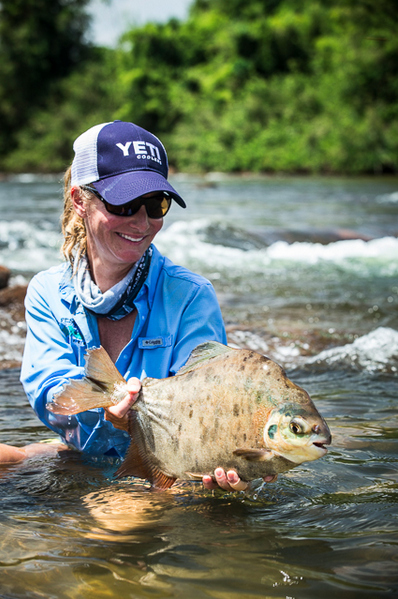
I continued to work the water upstream until a 5-6′ coral striped SNAKE swam into my waters 60 feet away (60 feet too close)! Wading at chest deep, I moved to higher ground, upstream and away from the “apparently” non-venomous snake. Venom or no venom, I don’t like snakes.
I do, however, like butterflies, and they are everywhere. Yellow, chartreuse, black and orange ones. It’s amazing how they’ll just flock around you as you fish.
At 12:30, the biggest highlight of the day happened when I walked up river by myself. I was working the cast behind boulders in the middle of the river when a big algae colored pacu slowly sipped my hopper, pool toy. So cool. The fight was on, and again, my fish played dirty. But I was determined to land this one and used my fresh water trout knowledge: I lowered my rod tip parallel to the water and while swinging the fish towards the shore. It worked!!! I brought in my first-ever “rubber” pacu (called this because the Indians think the meat is a bit rubbery). Pretty certain this one hadn’t been written up in the IGFA books, I documented my catch by gathering three measurements: center of fork length, end of fork length, and girth. We also used my certified boga on this sweet 5.25 lbs dish looking fish. Then back in the water it went.
All the excitement made us hungry so we met the Indians down river where they were cooking up a pacu they had hand-lined earlier. Lunch was perfect and delicious. With the air so still and humid, and the warmness of the water really offering no relief, we were all craving something cold and delicious. Chef Leandro had also prepared a beef salad with onions and peppers; penne pasta with sun dried tomatoes, cheese, and ham; and one of my favorite protein staples, a hard-boiled egg. Brownies were served for dessert, but from my past trips to Tsimane and Marié, I knew that the Indians really appreciate prepared sweets, so Matt, Roberto and I handed them over to our guides.
After a relaxing lunch in the shade, Matt asked to borrow my rod for a couple of casts. Not even five casts in and right in front of us … bam, he caught his first Brazilian fish, a matrincha on the pool toy.
That spurred me and Rodrigo out of our comfy camp chairs to begin our afternoon session. Roberto and Gui went right upstream, and I started in the slower water in front. After a few casts, I spotted a melanaei peacock 20 feet in front of me, in a quiet little pocket. I drifted my hopper over him twice, and got nothing. Then, thinking of bass, I “popped it.” That got his attention, and he chased it on to the deep rocks, having to turn on his side to eat it. I love the aggression! I landed my first peacock of the trip, and luckily Matt captured some incredible macro photos. The hopper popper.
Next came a tiny little pacu peba, looking radiant with his orange bottom front fin. His mouth wasn’t big enough to inhale my pool toy, but it was big enough to get the hook in.
While I worked my way downstream, I heard lots of hoots and hollering from Roberto and Gui. Roberto had caught several brightly enthused peacocks and a nice Bicuda. “They jumped and jumped,” he exclaimed.
Not much was happening in my waters, so a couple of the Indians guides and I started to make our way back to the boat. Halfway back, I spied three pacus behind a rock in a slick I’d previously thrown at with no luck. I threw my black painted “Pool Toy” hopper, which bounced off the rock and “hopped” right into the quiet eddy—and all three pacu raced for it. Luckily the big guy inhaled it first, and it was another dirty fight. I again used that down and dirty, low angle to bring him into my feet. Matt put down his camera to help, as this one was a bigger. Maybe 3lbs.
From there, we took the boats a little downstream, where I switched to my Sage One 8wt with Rio Outbound Short Intermediate Tip. Several peacocks, piranhas, and matrinchas followed, but the warm water caused by the full moon and drought had them feeling pretty lethargic. I managed to convince one little peacock and a bicuda to eat, but the day was done and so was I. Amazonian heat can sap your energy. It was time for a cold shower and a nice glass of fruit juice.
Appetizers are always good at Untamed Angling Lodges, and wonderful assortment of salty treats were waiting for us: pear and pesto pizza, salami pizza, Pringles, olives and nuts. I’m not sure why, but I always crave salt after a day on the water.
Dinner was delicious and followed by another trip highlight. Two of the Kayapos women offered to paint their tribal warrior patterns on our arms, using carbon coal from the fire and coconut oil. Matt, Brian, Ken, Roberto and I accepted. I asked for a turtle, Ken wanted a snake, and Matt was open and got a cool design. The women used flat sticks and their fingers to paint and apply the designs, which last about 5-7 days, depending on how much you shower and use soap and sunscreen.
Heading camping tomorrow for the first time in maybe 30 years? Ha. This should be an adventure. Praying no snakes!!!
– Meredith McCord





